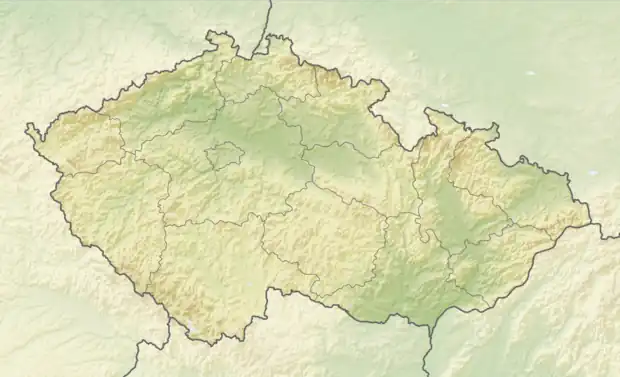Dívčí Hrad | |
|---|---|
 Dívčí Hrad Castle | |
 Flag  Coat of arms | |
 Dívčí Hrad Location in the Czech Republic | |
| Coordinates: 50°14′38″N 17°38′3″E / 50.24389°N 17.63417°E | |
| Country | |
| Region | Moravian-Silesian |
| District | Bruntál |
| First mentioned | 1267 |
| Area | |
| • Total | 12.05 km2 (4.65 sq mi) |
| Elevation | 307 m (1,007 ft) |
| Population (2023-01-01)[1] | |
| • Total | 295 |
| • Density | 24/km2 (63/sq mi) |
| Time zone | UTC+1 (CET) |
| • Summer (DST) | UTC+2 (CEST) |
| Postal code | 793 99 |
| Website | www |
Dívčí Hrad (German: Maidelberg) is a municipality and village in Bruntál District in the Moravian-Silesian Region of the Czech Republic. It has about 300 inhabitants.
Geography
Dívčí Hrad is located about 30 kilometres (19 mi) north of Bruntál and 61 km (38 mi) northeast of Ostrava. It is situated in the Osoblažsko microregion on the border with Poland. It lies in the Zlatohorská Highlands. The highest point of the municipality is the hill Hraniční kopec with an elevation of 352 metres (1,155 ft), located on the Czech-Polish border.
The Osoblaha River flows across the municipality. There are two ponds in the municipal territory, called Dívčí Hrad and Pitárno.
Oblík Nature Monument consists of a basalt hill with statigraphic and paleontological significance. There are fossils of crinoids, corals, cephalopods and brachiopods from the Cretaceous.[2] It has an area of 23.3 ha (58 acres).[3]
History
The first written mention of Dívčí Hrad is in the will of Bishop Bruno von Schauenburg from 1267, when the local castle was called Deuviz.[4][5]
In 1474, the castle was conquered and destroyed by the army of Matthias Corvinus. Around 1573, a new Renaissance castle was built by Hynek Bruntálský of Vrbno on the site of the castle ruin. In 1580, Dívčí Hrad was bought by the Sedlnický of Choltice family, and after it was confiscated from them in 1622, it was acquired by the Teutonic Order. In 1768, Dívčí Hrad was acquired by the Knights Hospitaller, who owned the castle until the 20th century.[6][7]
From 1976 to 1990, Dívčí Hrad was an administrative part of Osoblaha. Since 1990, it has been a separate municipality.[5]
Demographics
|
|
| ||||||||||||||||||||||||||||||||||||||||||||||||||||||
| Source: Censuses[8][9] | ||||||||||||||||||||||||||||||||||||||||||||||||||||||||
Transport
Dívčí Hrad is served by the Dívčí Hrad stop on the narrow-gauge Třemešná ve Slezsku – Osoblaha Railway, but the stop is located just outside the municipal territory.
Sights
The main landmark is the Dívčí Hrad Castle. This Renaissance castle is architecturally related to northern Italian churches with elements of fortress architecture. The castle was severely damaged during the World War II and then reconstructed.[6]
References
- ↑ "Population of Municipalities – 1 January 2023". Czech Statistical Office. 2023-05-23.
- ↑ "Přírodní památky" (in Czech). Osoblažská úzkokolejka. Retrieved 2022-05-06.
- ↑ "Oblík" (in Czech). Nature Conservation Agency of the Czech Republic. Retrieved 2023-10-30.
- ↑ "Testament olomouckého biskupa Bruna ze Schauenburku z roku 1267" (in Czech). Obec Dívčí Hrad. Retrieved 2022-05-06.
- 1 2 "Program rozvoje obce Dívčí Hrad na období 2021–2027" (PDF) (in Czech). Obec Dívčí Hrad. p. 5. Retrieved 2022-05-06.
- 1 2 "Zámek Dívčí Hrad" (in Czech). Tourism Information Centre Krnov. Retrieved 2022-05-06.
- ↑ "Zámek Dívčí Hrad" (in Czech). Osoblažská úzkokolejka. Retrieved 2022-05-06.
- ↑ "Historický lexikon obcí České republiky 1869–2011 – Okres Bruntál" (in Czech). Czech Statistical Office. 2015-12-21. pp. 3–4.
- ↑ "Population Census 2021: Population by sex". Public Database. Czech Statistical Office. 2021-03-27.